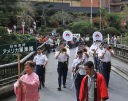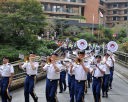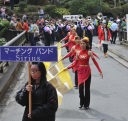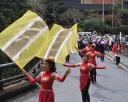 |
 |
 |
 |
 |
| Return to Top Page |
| Return to November Return to Museums |
| HAKONE is a town in southwestern Kanagawa Prefecture located on the lake Ashinoko. Hakone developed as a post-station town on the Tokaido, the major highway during the Edo period (1600-1868). A barrier station, Hakone-no-seki, was established here by the Tokugawa shogunate in 1618 as a checkpoint to secure the defense of Edo (now Tokyo). Traffic through this strategic nexus was tightly controlled. People were carefully checked for weapons here. The town is the official center of the Fuji-Hakone-Izu National Park, serving as a tourist base for the lake Ashinoko and the mountain Hakoneyama. The city affords a maginificent view of Mt. Fuji. There are several hot springs in the area. The remains of the barrier station, the cedar-lined Tokaido, a cluster of stone Buddha images dating from the 12th century, and the Hakone Open-Air Museum are other attractions. A parade, reminiscent of Edo period daimyo processions, is held every year on November 3. (quoted from Kodansha Japan Encyclopedia) |
HAKONE DAIMYO GYORETSU
(Hakone Yumoto Every Year on November 3)
| Hakone Yumoto is one of the largest hot spring town in Japan. There are more than 50 hotels and ryokan in a small town holding about 150 geisha girls. |
Music and Marching Band Parade
Geisha Parade
Matchlock Demonstration Firing
Daimyo Gyoretgsu
Hakone Yumoto Sceneries
HAKONE OPEN-AIR MUSEUM
| MUSEUM: Hakone Open-Air Museum opened in 1969 as the first open-air art museum
in Japan in the stunning landscape of Hakone. The museum is the permanent
home for approximately 120 works by well-known modern and contemporary
sculptors. It also has five exhibition halls including the Picasso Pavillion,
as well as pieces where children can play, a footbath fed by natural hot
springs, and variety of other facilities where visitors can relax and enjoy
the splendor of art in nature. Sculpture: Over 100 pieces of masterwork are displayed on the 70,000 square meter exhibition grounds, including examples from world famous sculptors as Rodin, Bourdelle, Miro and Moore. The Picasso Collection: Over 300 works centering around a large assortment of pottery purchased from Picasso's eldest daughter, Maya Picasso, also includes a variety of paintings, prints, sculptures and gold and silver objects. The above pieces are all on rotating display in the Picasso Pavillion. At the pavillion people can also enjoy a large number of portraits of Picasso taken by David Douglas Duncan over the last 17 years of the artist's life. The Henry Moore Collection: The Hakone Open-Air Museum has one of the world's largest collection of works by the British master sculptor. Twenty-six pieces of the museum collection are offered to the visitors providing a penetrating look into the artistic sensibilities of the sculptor who proclaimed that "sculpture is an art of the open air." Facilities: In order to provide a space for relaxation and entertainment, the Hakone Open-Air Museum comprises a variety of restaurants and shops in addition to the exhibition galleries. Footbath Spa "Hot Foot" for healing weary feet is a popular site at the museum. (from the Hakone Open-Air Museum web site) |